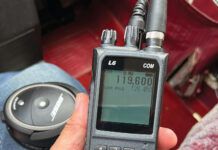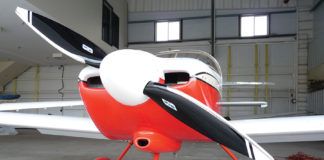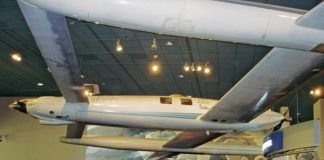It’s been my observation that most good homebuilt aircraft are never really “done.” Sure, they earn the coveted Experimental airworthiness certificate, sport registration numbers and pass their test-flight regime, but the really good projects are nowhere close to being complete. Builders who fly a lot, as we do, tweak. That’s because the newly built machine only really begins to talk to the builder/pilot once he or she develops a flying relationship with it. Trust me on this. I am not anthropomorphizing. Airplanes, especially hand-built airplanes, have personalities. They are more than the sum of their parts. And the people who fly them? Well, I don’t even need to go there. You know who you are. Our projects, a Kitfox 4 and an RV-10, are testament to the phrase “90% done, 90% to go.” We’ve swapped out engine components—heck, even the whole engine on one, cowlings, plenums, landing gear and, most recently, we upgraded avionics.
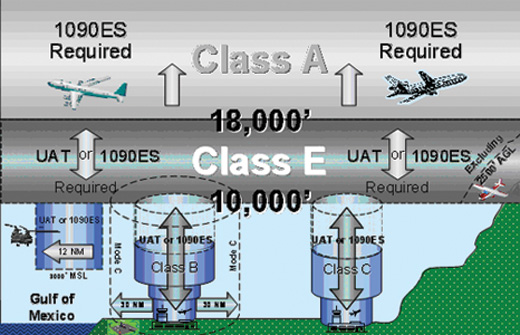
So just what does the ADS-B equipage rule say? Here’s a diagram of the basics. UAT-equipped aircraft are fine below 18,000 feet. High fliers must have 1090ES squitters, which do not have the bandwidth to carry the weather information with traffic.
Time for a Change
This upgrade was a money-saving measure. Yes, it can be done, but of course you have to spend it to save it. Our first investment came right after the 2011 EAA AirVenture show with the purchase of a NavWorx ADS600-B box (www.navworx.com). The transceiver, which provides both Automatic Dependent Surveillance-Broadcast (ADS-B) Out and ADS-B In services, meets the 2020 equipage regulations recently ratified by the FAA for aircraft operating at altitudes less than 18,000 MSL. It gives us the ability to see Nexrad weather radar images superimposed on our routing in our Grand Rapids Technologies Horizon I EFIS and other weather products. An added bonus is that the transceiver also provides us with traffic information, something we’d never had in the cockpit.
Why did we choose this upgrade? We’d been subscribers to XM WX Satellite Weather, received via satellite and displayed on a small HP iPAQ, for years. But the iPAQ was getting squirrelly and the receiver, at six years old, had its moments, too. Then there was the $39 a month, minimum, that XM Radio charged us for its services, whether we needed them or not. It all added up to push us toward the new technology.
The math was easy. The new box would pay for itself in savings over XM’s monthly subscription and equipment costs within two years. The kicker, though, was when we took a close look at a current ADS-B coverage map for the U.S. and Canada. We saw right away that most of the areas in the U.S. where we typically fly are well-blanketed by ADS-B. That meant we could receive both weather products and traffic everywhere we currently fly, and probably most places we are planning to visit in the next year or two. Odds are, by the time we get to some of the more far-reaching spots, ADS-B will be there, too.
We were also convinced, after talking with a few more educated souls, that the installation and application of the ADS-B box would be relatively simple. Eventually, it was. But we did have to do some prep work; this was not plug and play.
Bill Moffitt, principal at NavWorx, assured us we’d have one of the first boxes coming out of the production run after AirVenture. Even so, eight weeks passed before it arrived. The delay was a godsend, however, because it gave us time to rewire, freeing up a high-speed port on the GRT Horizon I EFIS and still maintaining the redundancy we demanded between the two EFIS and AHRS units that we have in the aircraft. Full disclaimer here: We did not do this alone. Tech support at both NavWorx and Grand Rapids was wonderful to work with during this process. We also had to prepare our transponder to be wired into the transceiver via its serial port. Ultimately, the NavWorx would take over for our Garmin 327 Mode C transponder, so it was essential that they communicate.
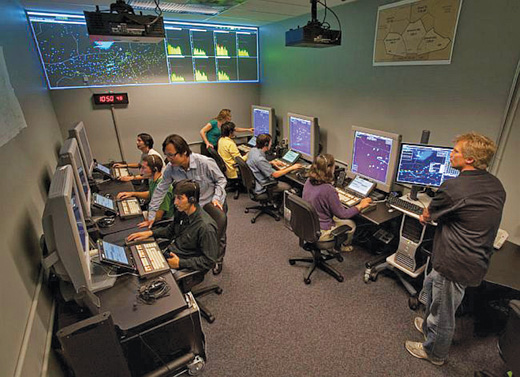
A modern ATC facility with ADS-B capability. The NavWorx ADS600-B transceiver both sends and receives ADS-B signals to satellites, ATC ground stations and other ADS-B equipped aircraft, providing traffic separation in real time. What’s nice about the UAT-based system is that it also provides a range of weather products, from METARS and TAFs to cloud tops aloft and full Nexrad imagery. And for now, taxpayer dollars fund it, so it is fee-free.
Making It Work
How much rewiring did it take? Well, just about every plug going into the two EFISes was unplugged and shuffled, as well as the wiring for the transponder. As we worked (slowly and meticulously, I might add), we documented everything, updating the original wiring schematic as we went along. The idea was to try and keep it simple for future maintenance.
Second on the list of must-dos before the NavWorx box turned up was pulling wires from the front of the airplane to the back, behind the luggage bulkhead, where the avionics equipment is mounted. We have conduits in place from the original build, which simplified the procedure. However, it still took two people and a bit of lubrication to make the process go smoothly. We chose to mount the transceiver on the aircraft sidewall, as other RV-10 builders have done. The box came with integral mounting brackets, which made the task easy.
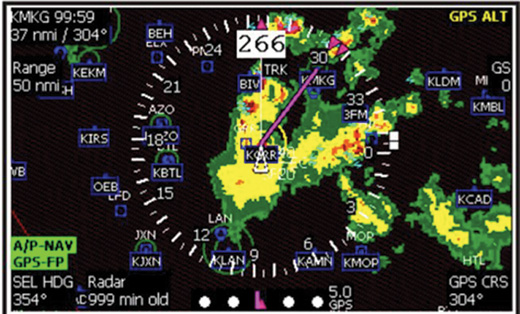
When it comes to weather en route, a picture’s worth a thousand words. It is easy to get around storms you can see for 100 miles on Nexrad. ADS-B lets you do it.
We knew from talking with Moffitt that we’d need two antennas: one for the GPS and one for the UAT signal. We got the UAT antenna (really just a transponder antenna) from NavWorx, and found a used GPS antenna at a local avionics shop for a reasonable price. We mounted the GPS antenna underneath the horizontal stabilizer fairing to keep things clean. The UAT antenna, however, went right on the aft belly. We were careful to measure distances between these and our other antenna to eliminate potential interference.
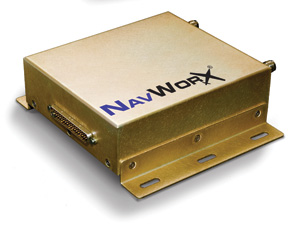
Programming the NavWorx transceiver is essential before the first flight. You’ll need a computer that can run Windows and a terminal-emulation program, as well as a way to plug into the 9-pin serial port provided by NavWorx.
By the time the transceiver arrived we were ready to mount it and plug everything in. Except, we had no manual. This is where being an early adopter can be a challenge. The manual had been inadvertently left out of our shipping box, and we could not find one anywhere on the company web site. NavWorx was quick to email us one,
however, and we were back in the installation business. A compulsory read of the entire manual left us with copious notes and a few good questions that Moffitt was great about answering. First off, we learned we’d need a laptop with a Windows operating system and a 9-pin serial-to-USB converter to complete our task. Once we had the laptop up and running, we had to download and install a small terminal-emulation program, which essentially turned the laptop into a dumb terminal for the NavWorx box, allowing us to program it with essential information that branded the transceiver to our specific airplane.
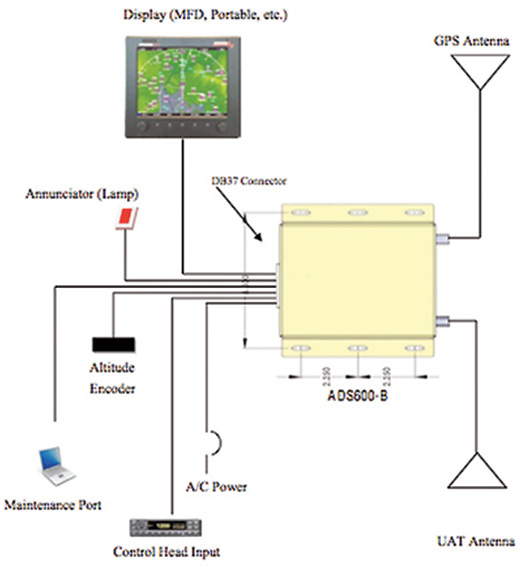
Wiring the box properly is key, and here’s why: It is connected to both your EFIS and your transponder.
It wasn’t rocket science, but all of it took time. As with any programming, it pays to work slowly and check your progress. The manual was essential for understanding the programming language of the box. Unfortunately, the freeware it specified for the terminal emulation (Terra Term) had been updated recently, so it took a little guessing to figure out how it should be configured; the screenshots did not match up with what the program now offers. Again, not a deal-killer, just a place where you’ve got to pause and use logic to figure out what to do next.
What were we programming? Well, each aircraft is assigned a unique hexadecimal ICAO code in the ADS-B system, as well as its N-number, which will display on other UAT-equipped aircraft in the system. You are also teaching the box and your transponder how to get along, a critical component for ease of operation. It took us three attempts over two days to get it just right. After that it was time for a test flight. We picked a clear day so that ATC wouldn’t be too busy and would be willing to work with us to test our transponder output.
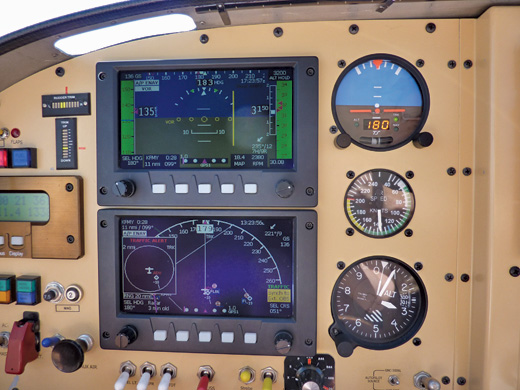
This is what the author had never seen before in the cockpit: traffic! On the GRT unit’s screen, up pops a large 2-n.m. circle any time a potential conflict arises.
The NavWorx transceiver worked amazingly well, picking up the ADS-B weather feed at 500 MSL and displaying traffic even quicker. Remember, we’d never had traffic depicted on an EFIS screen in the cockpit, and we were wowed by how many aircraft were out there. The system had the chance to demonstrate its own power when it generated a traffic alert and popped up to show us an airplane passing right under us that we’d never have known was there (ATC never called it to us, but it was quite close). We’d installed the box to get weather products in the cockpit, yet the test flight showed us immediately that the traffic function was far more than just a value-added product in the package. Now my husband felt he had all of the information he used to have in the big Boeings right at his fingertips. He smiled. We ran a check with ATC on the transponder function, and everyone concluded we were showing up in the right position with the proper squawk, altitude and data tags.
Troubleshooting
Perfection is fleeting, though. Our Garmin SL30 showed a com failure and wasn’t properly outputting ILS data to the Horizon I box. Turns out a wire was crossed. But how? Well, remember the wiring schematic we were updating? We discovered that it wasn’t an entirely accurate schematic. Apparently an update had been made even before our airplane ever flew, and it wasn’t properly recorded. Just goes to show you, your aircraft’s ultimate performance (or non-performance) is only as good as the plans. Once we fixed the crossed wire we tested the system in Class B airspace and found it worked like a charm. Nexrad was right on the screen, accompanied by a stream of weather data that helped us make early decisions on runways in use and even diversions for weather. But again, it is the traffic function that continues to impress us. In the busy Orlando airspace it saved my husband from a very near miss with a twin climbing rapidly from behind toward the RV-10 as he was departing. The ability to “see” aircraft on the EFIS that you simply can’t see out the window is, to us, as revolutionary as Nexrad weather depiction on-screen. Now that we have it, we can’t imagine flying without it.
We know there are a lot of unknowns associated with what the ultimate ADS-B equipment requirements will be in 2020. Some swear that UAT will go away and 1090ES squitters used by the airlines and high-flying aircraft will ultimately be the standard—or that the government never gives anything away—at least not for long. What’s our answer? Well, all that is years away, and we know the odds are that something’s going to change. Yet, now that we have the system in place, we’re OK with that. The price point versus value received, when compared to the XM system we had in place, made the retrofit worthwhile to us. And who knows? In a few years we’ll probably want to change something again anyway.
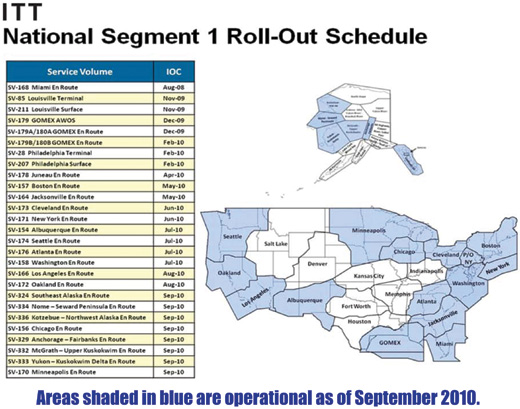
ADS-B coverage is quite thorough. The roll-out of services is expected to be complete by 2013, depending on whom you ask at the FAA (some say 2015, and some say whenever the funding comes through).
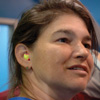
![]()
Amy Laboda has taught students how to fly in California, Texas, New York and Florida. She’s towed gliders, flown ultralights, wrestled with aerobatics and even dabbled in skydiving. She holds an Airline Transport Pilot rating, multi-engine and single-engine flight instructor ratings, as well as glider and rotorcraft (gyroplane) ratings. She’s helped with the build up of her Kitfox IV and RV-10.










